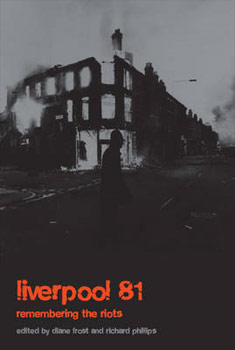
| HOME |
| NERVE |
| REVIEWS |
| ARCHIVE |
| EVENTS |
| LINKS |
| ABOUT US |
| CONTRIBUTORS |
| BACK ISSUES |
| CONTACT US |
 Liverpool
’81: Remembering the Riots
Liverpool
’81: Remembering the Riots
Written by Diane frost and Richard Phillips
Liverpool University Press,
£14.95
Reviewed by John Owen
“Outside the entire skyline is angry crimson. Dense banks of black smoke hang threateningly above the rooftops...the view is like a Hieronymus Bosch painting of hell”
Arising out of the events and meetings held to commemorate the uprising of 1981 by Rioting On The Wall, this view of Liverpool in 1981, two years into the Thatcher government, asks the question ‘Where Were You?’ Those of a certain age cannot comprehend the magnitude of the impact the riots had, much like the way WW2 was presented to us in school; it is already receding into history and its ghost-like fascism is a mere historical fact in a book. However, for most of us these testimonies are far too real, they took place not in some faraway land but right here and involved all of the people of Liverpool so I suppose we should also ask where did you stand on the issue of racism?
Chapters begin with what happened; experience and memories outlining some of the original incidents that sparked the reaction. The arrest of Leroy Cooper by police for theft to later seeing how a solution could be developed by focusing on positive strategies is looked at under the heading “Dealing with Police and Communities”. “Inner City” describes the area and the atmosphere before and during the riots, and then “Young People and Education” focuses on the prospects and legacies that can be handed down to future generations.
Finally, “Economic Problems and Solutions” deals with the massive problems afflicting the inner city since the post-war malaise, here Tarzan, or Lord Heseltine, comes into the picture to help redress the balance. He does this by throwing a Garden Festival to cure the massive unemployment and years of underinvestment. He also proposes business solutions for social problems that have accumulated for over a century with the decline of the port of Liverpool.
The conclusion “Looking Back and Moving On” objectively looks at the upshot of all this research and what became of it all. Among the many reports were the “Scarman Report” highlighting institutionalised racism, the “Macpherson Report” which dealt with the problems of policing, the “Gifford Inquiry”, an attempt to put forward solutions for social advancement and progress and PACE (or Police and Criminal Evidence Act) all these on the back of the riots surrounding a small tight-knit community in the district of Liverpool 8 called Toxteth.
Alas the name has become demonised like the terrors of old, the reality is a lot different. Some people just want to move on while others contest that urbanicide has been carried out against the local black community. Now a new influx of migrants and culture has seen the area develop a lot differently from the close and personal identity or black consciousness that characterised the L8 of the 80s. Feelings are mixed and still divided over the need to dwell on the past or forget and move on, should we pass the torch to the younger generation in the hope that they can appreciate the struggles of their parents for change and how they sacrificed their own needs to create a better tomorrow?
Warts and all, this book brought back powerful memories and, for a brief moment, I felt a strong urge of riotous mania against the nearest policemen that was thankfully short lived for I know you can’t beat the system and the system will always win in the end, can I have bail now I want to see my brief.